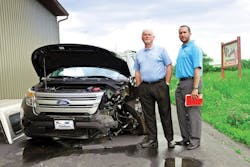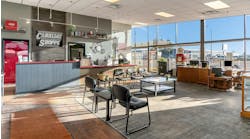Growing up, Andy Tylka wanted nothing to do with the family body shop business.
“I didn’t want to be in the shadow of my dad,” he says. “I wanted to create my own success, like my dad did.”
His parents, Tom and Debbie Tylka, founded Tom & Ed’s Autobody in 1983 and grew it to three locations in northern Indiana. Andy’s older sister also worked in the business, but Andy was determined to take a different path.
He chose to attend college, the first member of his family to do so. After earning a degree in public management and marketing at Indiana Purdue University Indianapolis, he developed and oversaw a successful indoor theme park that generated more than $15 million in annual revenue. He bought a house in Indianapolis, about three hours away from his hometown, and started putting down roots—until he heard things weren’t going well back home.
After learning of his dad’s plans to sell the family’s sliding body shop business, Andy made an impulse decision. He unloaded his house at a loss, quit his high-paying job, moved in with his parents and took over the repair centers. In less than two years, his fresh ideas and business savvy prompted a remarkable turnaround: Tom & Ed’s is on pace to be profitable this year—something that hasn’t happened since 2006.
“Even though I hadn’t been involved, all my memories are with that business,” says Andy, 28. “I couldn’t let that company and all my dad’s hard work go to waste.”
Body shop immersion
Tom Tylka wasn’t sure the transition would work, given his son’s inexperience, but he was thrilled about the possibilities.
“It was always a dream of mine to keep the business in the family. I thought my daughter would be the one [to take the shop], but it didn’t work out,” says Tom, who felt physically and mentally drained by the business. His lack of energy for the demands of the shop became evident as its performance lagged. His son, he thought, might help rejuvenate the facilities.
For Andy, the learning curve was steep. He immersed himself in the shop’s operations, spending a couple of weeks at each location, shadowing managers and receptionists and observing employees. “I just kept quiet and listened,” he says.
When Andy saw a problem, he asked about it, which helped him gain the trust of Tom & Ed’s 27 employees. From there, he was able to make changes without creating animosity in the shop. “I didn’t want to be looked at as the owner’s kid, so I wasn’t going to tell people what we were going to do,” Andy says. “I asked people questions so they could come up with the solutions themselves.”
Within 18 months, all of Tom & Ed’s shops showed improvement. The 16,000-square-foot facility in Schererville is on pace for $1.4 million in annual revenue; the 8,000-square-foot Crown Point store is on track for $2.4 million; and the 8,000-square-foot shop in Merrillville is on its way to $1.1 million. And the growth is in a saturated market—Andy’s dad says they have to steal much of their business from competitors to grow.
Andy revived not only the business, but also his dad’s enthusiasm for collision repair. Here’s how he did it:
Standard operating procedures (SOPs). Staff tended to blame everyone for everything and lacked a clear understanding of who was responsible for what and how the process worked, Andy says. So instead of confronting the problem, staff would get upset with whomever they assumed needed to perform the task.
Educating the staff on the overall processes and why the shops did things the way they did helped tremendously. Andy implemented SOPs backed with reasoning for each step. Now it’s clear how and why tasks are completed in a certain way.
The entire operation is more cohesive thanks to the consistency of SOPs, and employees sense the difference. “It’s not three separate locations anymore,” says Jamie Kornacki, Tom & Ed’s former receptionist, whom Andy promoted to controller. “It used to be disjointed. Before, each location had its own meetings. He put us all together.”
Andy also implemented cross-training for employees. That created an understanding of how each person and task fits in the repair process. As a result, the shop stays productive even when someone is absent.
Budget cuts. Andy reviewed the business expenses and found a couple of big, unnecessary expenditures. Tom & Ed’s paid for two estimating software systems because of past insurer needs, but one hadn’t been used for six years. Andy got rid of it and saved the business $6,000 per location per year, an annual savings of $20,000.
The business was also paying too much for its phone and Internet bill, simply because no one had reviewed or renegotiated the charges. By dropping unnecessary subscriptions, Andy cut the bill 25 percent, saving Tom & Ed’s $10,000 annually.
Budget, period. Tom Tylka admits he is no accountant. In fact, for many years, he ran and even grew his business without an annual budget. “I must have done something right in the 28 years I was in business,” he quips.
Andy, a number cruncher by nature, quickly drafted the company’s first budget and sales goals, which involved calculating the break-even point for each facility.
Budget-savvy employees. “Most of the staff at Tom & Ed’s hadn’t realized that, after the financial losses during the past few years, we had to make some drastic changes to remain in business,” Andy says.
And while that ignorance might have been blissful, it also led to a lack of value and loyalty among employees.
– Andy Tylka
Andy put together a presentation explaining gross and net profit and the staff’s role in boosting the bottom line. He launched a bonus program for management based on sales goals, and he’s developing an incentive program for other employees.
That information and those incentives have increased productivity, Andy says.
Kornacki can attest to the changed work environment. “Everyone in the company understands why we need to hit these numbers,” she says. “And who doesn’t want to make more money? It was always kind of confusing before. It’s hard to motivate people when they don’t know what they’re going for.”
Dealership connections. Andy has focused on developing relationships with the region’s dealerships, rather than knocking on insurers’ doors for business. He has developed strong connections with nine dealers, earning exclusive rights to referrals from four. He provides dealers with pamphlets for customers, which contain the Tom & Ed’s logo and instructions on what to do in case of an accident.
“Dealerships love those things,” Andy says. “They get recognition, and we [get] a map on the back. I want to make sure the business comes to us.”
Improving workflow. Simply organizing the shops so tools and equipment are located for maximum efficiency has made a big difference in how things get done, Andy says.
“In the kitchen, you’re going to put the salsa with the nachos, that’s a no-brainer,” he says. “Why put a tool on the complete opposite side of the room and make a tech walk across the room?”
In the past, techs also had to ask for a key to the supply cabinet, a tactic meant to prevent theft. But it ended up wasting time, so now everything is always available. Andy keeps close tabs on material usage and explains to employees how much product they have available each month according to the budget.
Industry education. Andy has made a point to attend industry conventions, such as the PPG MVP conference in Palm Springs, Calif., and take I-CAR classes to improve his knowledge of the industry.
He also wants to get more hands-on training.
“While being new to the industry, I am engulfing myself in all the knowledge possible to be a leader in my field,” Andy says. “You have to know a quality repair. That’s a big deal to me.”
Recording ideas. Andy is never without a little red notebook, which he uses to jot down ideas as they come to him, so they’re not forgotten.
Many of the ideas have evolved into shop strategies.
“I keep this puppy right next to my bed at night,” Andy says of the notebook. He’s on his way to filling up his second one since joining Tom & Ed’s.
A new career path
These days, Andy is looking to move out of his parent’s place for a second time. He’s house-hunting and again looking to put down roots—roots that will keep him close to the family business.
Andy and his dad have gone to workshops on family business transitions and are looking at how to best pass the torch officially.
Tom says he plans to retire, at least partially. Although, his shop-floor knowledge has proven valuable to Andy and the two make a good team. They recently launched a 24-hour wrecker service to create an additional revenue stream for the business.
“I’m very proud of him,” Tom says of his son. “He’s [improved] cash-flow, got a handle on the accounting, and things are going well.”
And Andy’s future plans couldn’t be more different from those he envisioned when he enrolled in college. He aims to build the business so he can add new locations. “I’m excited to do this for the rest of my life,” he says.



